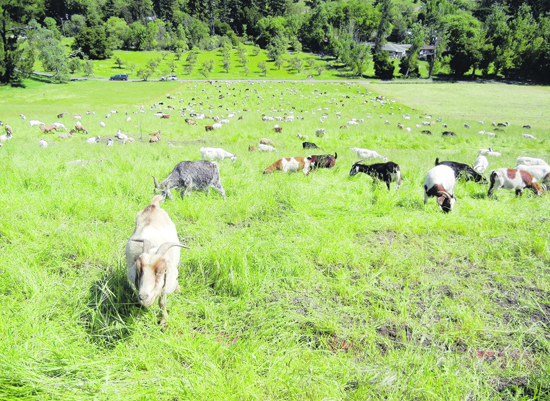 | | | Photos Rosylyn Stenzel
| | | | | | Just one mile from civilization, Lafayette Reservoir is ideal for hiking, jogging, fishing, boating and picnicking. Turns out it's good for goats, too. But the recently sighted goats, 600 in all, weren't out for a stroll in the park; they were working to clear the rim trail of scrub brush and eliminate wildfire fuel.
 Orindans Terri Oyarzun, her husband Egon and their son Zephyr own Goats R Us, a goat grazing-for-hire business formed in 1995. The family keeps rescue goats and goats of mixed parentage forming what Oyarzun calls "a nice blended community."
Orindans Terri Oyarzun, her husband Egon and their son Zephyr own Goats R Us, a goat grazing-for-hire business formed in 1995. The family keeps rescue goats and goats of mixed parentage forming what Oyarzun calls "a nice blended community."
 They originally planned to offer grazing services to property owners along the Berkeley Hills, but they ended up serving more commercial and public properties. About 15 years ago the goats cleared brush on Mills College acreage. That job earned a goat named "Cookie" an International Brotherhood of Teamsters shop jacket and a moment of fame on TV's Comedy Central.
They originally planned to offer grazing services to property owners along the Berkeley Hills, but they ended up serving more commercial and public properties. About 15 years ago the goats cleared brush on Mills College acreage. That job earned a goat named "Cookie" an International Brotherhood of Teamsters shop jacket and a moment of fame on TV's Comedy Central.
 "Goats are a fireman's best friend," says Oyarzun. They are even considered a tool in California's fire mitigation kit. Moraga-Orinda Fire District Emergency Coordinator Dennis Rein says Oakland and El Cerrito use goats to clear away vegetation, as does East Bay Municipal Utility District.
"Goats are a fireman's best friend," says Oyarzun. They are even considered a tool in California's fire mitigation kit. Moraga-Orinda Fire District Emergency Coordinator Dennis Rein says Oakland and El Cerrito use goats to clear away vegetation, as does East Bay Municipal Utility District.
 Although the Oyarzuns' herds are friendly, it's best to admire the goats from a distance. "They're not a petting zoo," she says. Besides, they're corralled behind a portable electric fence. They did manage to jump a fence once and enjoy a moment of "the grass is always greener on the other side" in an Orinda resident's back yard. The homeowners, who had just moved into the house, took the invasion good naturedly and the goats were eventually persuaded to return to their work site. As for retirement, the Goats R Us website (www.goatsrus.com) promises "when a goat's 'golden years' approach, their scope of work is kept local, and they're allowed to roam the [Oyarzuns'] hillside ranch." Nice work, if you can get it. Not baaaaad at all.
Although the Oyarzuns' herds are friendly, it's best to admire the goats from a distance. "They're not a petting zoo," she says. Besides, they're corralled behind a portable electric fence. They did manage to jump a fence once and enjoy a moment of "the grass is always greener on the other side" in an Orinda resident's back yard. The homeowners, who had just moved into the house, took the invasion good naturedly and the goats were eventually persuaded to return to their work site. As for retirement, the Goats R Us website (www.goatsrus.com) promises "when a goat's 'golden years' approach, their scope of work is kept local, and they're allowed to roam the [Oyarzuns'] hillside ranch." Nice work, if you can get it. Not baaaaad at all.
 For more on goats as a fire prevention assets read: http://www.firescience.gov/projects/briefs/99-1-3-02_FSBrief34.pdf
For more on goats as a fire prevention assets read: http://www.firescience.gov/projects/briefs/99-1-3-02_FSBrief34.pdf

|
